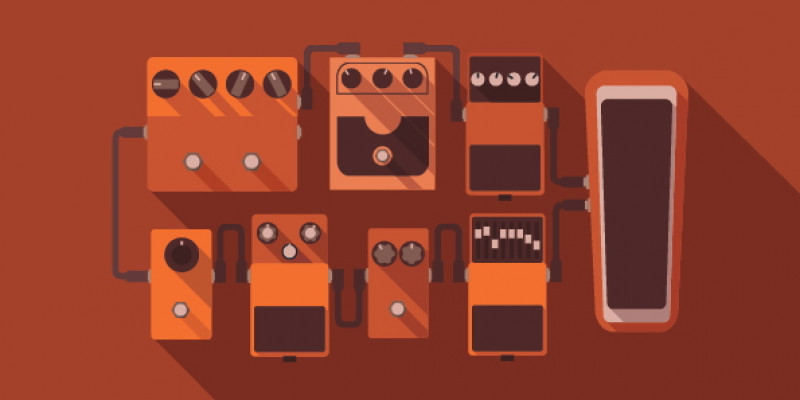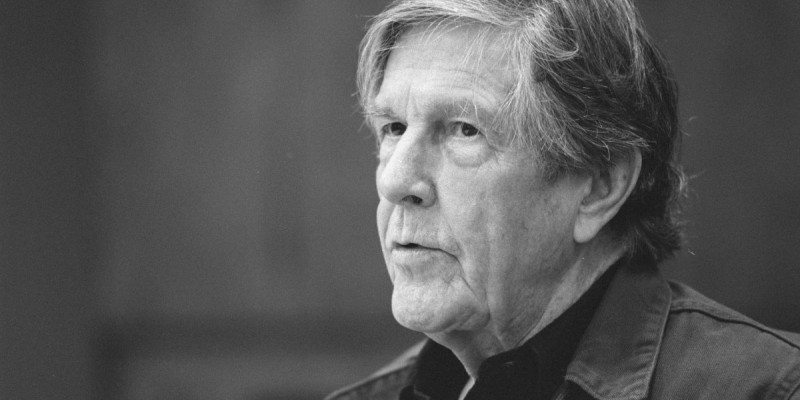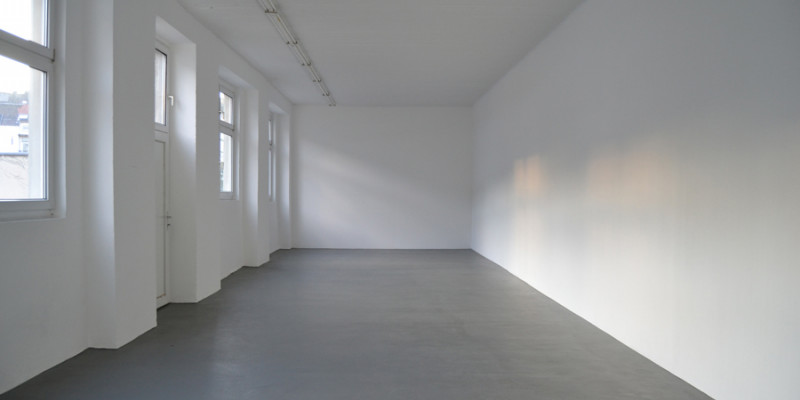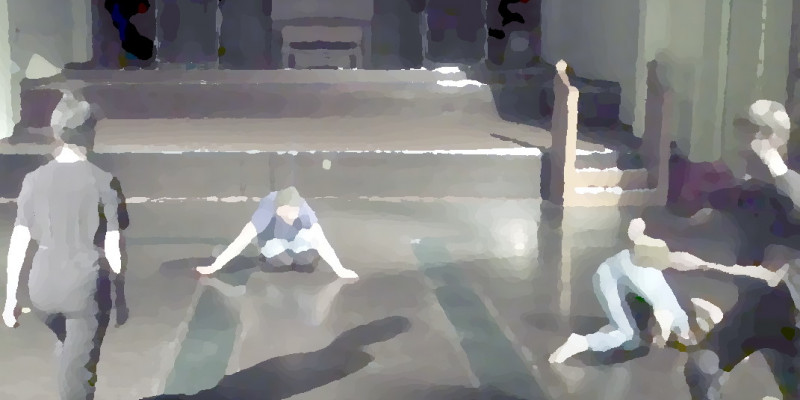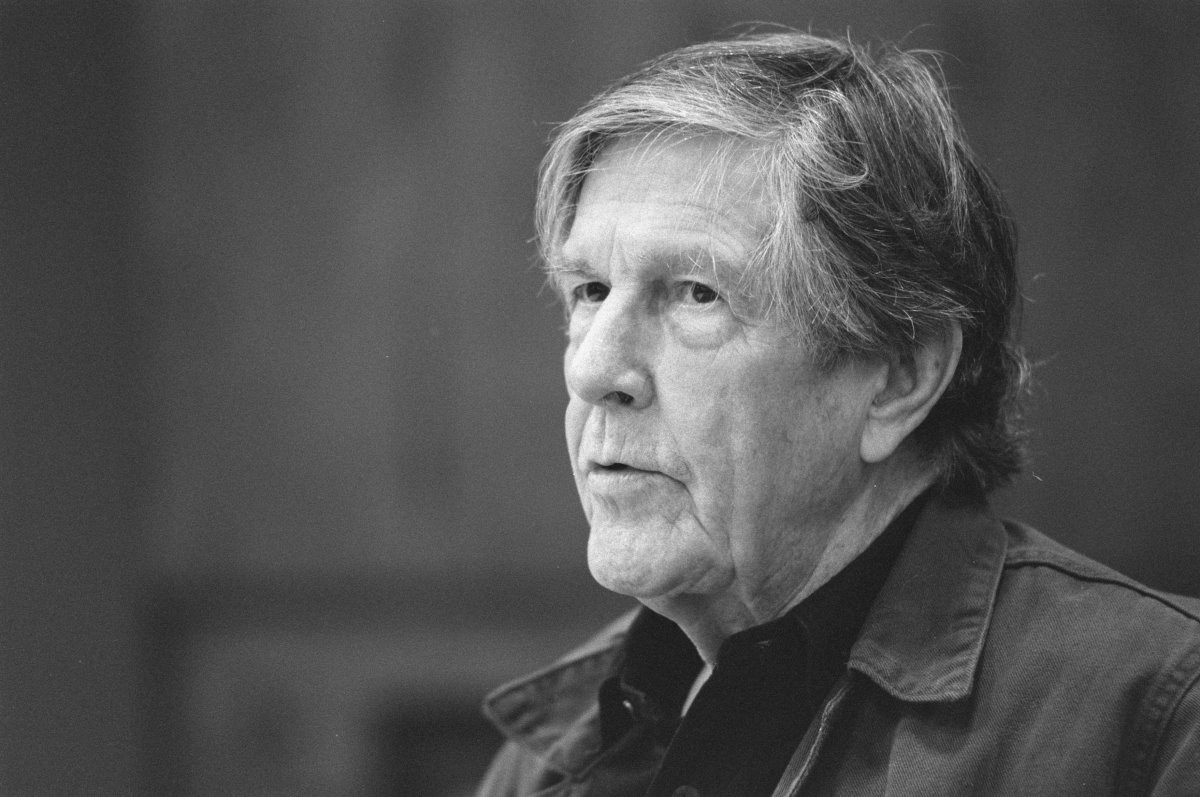
The composer as curator
Abstract
In 1989 John Cage started working on a commissioned project for the Museum of Contemporary Art, Los Angeles – a chance-derived, four-movement composition for museum entitled Rolywholyover A Circus. This was a long-term performative, multicentred event for gallery installers, audiences, artworks, artifacts, scores, plants, stones, books, chess tables, chairs, and pieces of ephemera.
While doing trials and preparations for Rolywholyover, Cage composed two other compositions for museum, both smaller in scale: Changing Installation (1991) for the Mattress Factory in Pittsburgh and museumcircle (1991) for the Bayerische Staatsgemäldesammlungen, Neue Pinakothek in Munich.
Cage wasn’t the first artist, of course, to explore the museum-exhibition apparatus, but his exhibition strategies manifested something new. As a composer, Cage created exhibitions in a manner akin to the ones he used to create his musical compositions, and as such, his exhibitions functioned like his music. By that, Cage deconstructed the governed gallery experience and formed a new field of research – the composer as curator – where the exhibition space adopts sound composition principles, and thereby, alters the concept of exhibition-making.
1. Introduction
In 1989 John Cage started working on a commissioned project for the Museum of Contemporary Art, Los Angeles (MOCA) – a chance-derived, four-movement composition for museum entitled Rolywholyover A Circus. This was a long-term performative, multicentred event for gallery installers, audiences, artworks, artifacts, scores, plants, stones, books, chess tables, chairs, and pieces of ephemera. According to Julie Lazar, the MOCA curator who worked with Cage on this project, while doing trials and preparations for Rolywholyover the artist composed two other compositions for museum. Both of these other works were smaller in scale: Changing Installation (1991) for the Mattress Factory in Pittsburgh and museumcircle (1991) for the Bayerische Staatsgemäldesammlungen, Neue Pinakothek in Munich.
Cage wasn't the first, of course, to explore the museum-exhibition apparatus. Duchamp, who significantly influenced Cage, for example produced a series of interventions as a curator-designer of exhibitions from as early as 1938.[1] But while Duchamp’s interventions radically re-conceived what the space of an art exhibition could look like, I would maintain that Cage’s exhibition strategies manifested something new. As a composer, Cage created exhibitions in a manner akin to the one he used to create his musical compositions and as such, his exhibitions functioned like his music.
All three of his compositions for museum have detailed chance-operation processes and lists of instruction that together, I would suggest, act as scores. These scores are like any of his other musical scores, and are available for curators to perform his compositions-exhibitions. Using a score, Cage applied the same ideas and methodologies to museums as he did to his music. For example, the composer allowed sounds to be “themselves” – that is, without any need for interpretation – and treated objects in the same manner by detaching them from language. No labels were placed beside the objects, though the objects were numbered and an enumerated list of the objects on display was available nearby.[2]
Time in a musical composition was replaced by space in a museum-related composition as the relevant dimension, and like any other piece by Cage, his compositions for museum were a “process”, as Cage often used to describe his practice (Cage 1981, pp. 134-35), and as such were a celebration of his work.
2. John Cage’s three compositions for museum
2.1 museumcircle, 1991
museumcircle was performed for the first time in the exhibition John Cage: Kunst als Grenzbeschreitung: John Cage und die Moderne [John Cage: Art as a Transgression of Boundaries: John Cage and the Moderns], which took place between 18 July and 27 October 1991 at the Bayerische Staatsgemäldesammlungen, Neue Pinakothek in Munich. Apart from museumcircle, the exhibition included some of Cage’s New River Watercolors series and the Ryoanji drawings, along with concerts of Cage’s music presented during the length of the exhibit.
In the exhibition catalogue Clelia Segieth writes that Cage sent his “concept” for museumcircle in a short note:
To make an exhibition in the Bayerische Staatsgemäldesammlungen in Munich of articles from other Munich museums, hung or placed in chance determined positions. To bring this about each museum may offer to come, say, a dozen objects. From the potential some chance formation will be used to select the actual ones to be used. (Cage 1991, p. 106)
I’m suggesting that this “note” is actually a score, and as with many of his later scores, it is one that is indefinite and open to the performer’s interpretation. Segieth writes that the unfixed instructions triggered questions: Which museums should be approached for the loans? Should the list of objects be related to Cage? And most of all: Should a project which has, so it seems, no logical sense and structure and therefore contradicts many conceptual and scientific patterns of thought, be executed in the first place (Segieth 1991, pp. 89-91)?
Soon enough it became clear to the exhibition organizers[3] that they would be forced to make decisions that would directly affect the composition process – and therefore, the exhibition itself. This turned the score-realization process into something as equally important as the performance/exhibition itself. Furthermore, Cage’s open and ambiguous score welcomed interpretation and decision-making, but the use of chance made sure that no direct influence – of the exhibition organizers and/or the lenders – would apply.
Segieth writes that, in this way, Cage even eliminated the subjectivity of the artist; he allowed the objects a space to exist independent from language. Inspired by Buddhist thought, Cage’s museumcircle emphasized the exhibition space not as self-determined and self-representative (be it in regards to objects, artists and their biographies, lenders and their histories, etc.) but rather as nonintentional, anti-authoritarian, and non-hierarchical.
The result of the museumcircle score was as surprising for Cage, perhaps, as it was for everyone else: a juxtaposition of artifacts, art, and everyday objects. Segieth compares museumcircle to Cage’s Europeras 1 & 2, and states that they are other examples of Cage’s approach to European art: Oriental thought is applied to Occidental materials in a particular situation in which nothing is conveyed in advance, and which may thus provoke new knowledge.
In Cage’s museumcircle the traditional “objet trouvé” is detached from any genre, quality, value, or context, and is left “only” with the complexity of the everyday. Visitors are obliged to create their own systems of references within a chaotic structure – a situation comparable to the natural, asymmetrical structure of a Japanese garden, writes Segieth. The visitor may feel the impulse to rearrange the objects on display, and to thereby change their ideas – and in that sense, museumcircle is not an exhibition that displays one existing plane of curatorial research, but rather a possibility of many.
In other words, museumcircle is a score for deconstructing the governed gallery experience. In that respect, this was not an exhibition about Cage in the same way a didactic retrospective exhibition of his works would be. It was a demonstration of his practice, an opportunity for the audience to be involved in its making. Visitors were able to not only look at or listen to his work, but to also become part of its realization – to perform it, to walk inside it, and experience it with all their senses.
According to Lazar, museumcircle was informed by Erratum Musicale (1913) – the first musical work of Marcel Duchamp.[4] In the spring of 2015, I performed museumcircle and Erratum Musicale in order to compare the performances of the two scores, and more specifically, to contemplate the consequences of Cage’s spatial adaptation of Duchamp’s sound. This project, entitled Image Coming Soon #1, was presented in Toronto at the Justina M. Barnicke Gallery, March to June 2015. The following images (figures 1 & 2) are from the curatorial performative process of museumcircle:
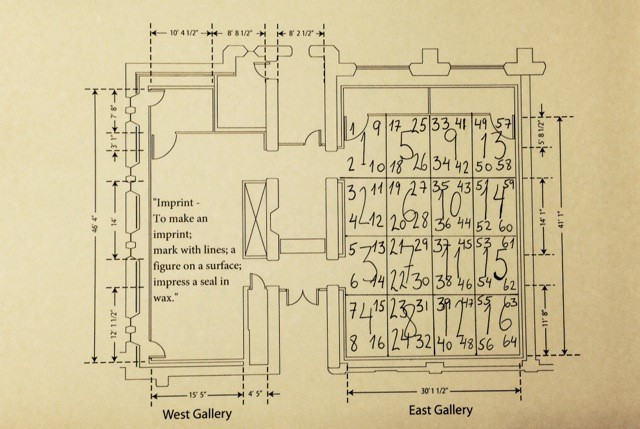
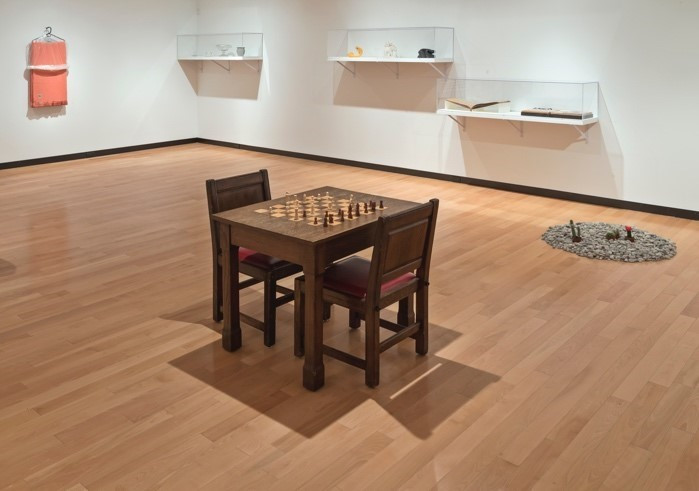
2.2 Changing Installation, 1991
Changing Installation was performed at the Mattress Factory in Pittsburgh between 19 October 1991 and 16 February 1992 as part of the Carnegie International – the fifty-first in a series of contemporary art exhibitions of the Carnegie Museum of Art.[5] Artists Barbara Luderowski and Michael Olijnyk, as co-directors of the Mattress Factory, invited Cage to install a new work at the institution and Cage initiated an “artist statement” for this work, which read:
In an empty room the chair(s), the walls neither painted nor the paint removed (the walls as they are), the use of chance operations to determine the placement and orientation of the chair(s) and which fifteen of a source of forty-eight works, twelve each by Dove Bradshaw, John Cage, Mary Jean Kenton, and Marsha Skinner are presented each day. (Giannini 2001, p. 45)
I would suggest that the above “statement” too acts as a score, but that unlike the score for museumcircle, Changing Installation’s score is for a process for creating an exhibition from a pre-determined pool of objects (rather than a more open-ended pool of objects). For Changing Installation, to be more specific, Cage chose twelve works of his own and asked the other three artists to do the same. He also wished to include chairs in Changing Installation, just as he had in his earlier sound and light installation Writings through the Essay: On the Duty of Civil Disobedience (1987). Ultimately, Cage chose seven chairs from what was available at the Mattress Factory, regardless of colour or design.
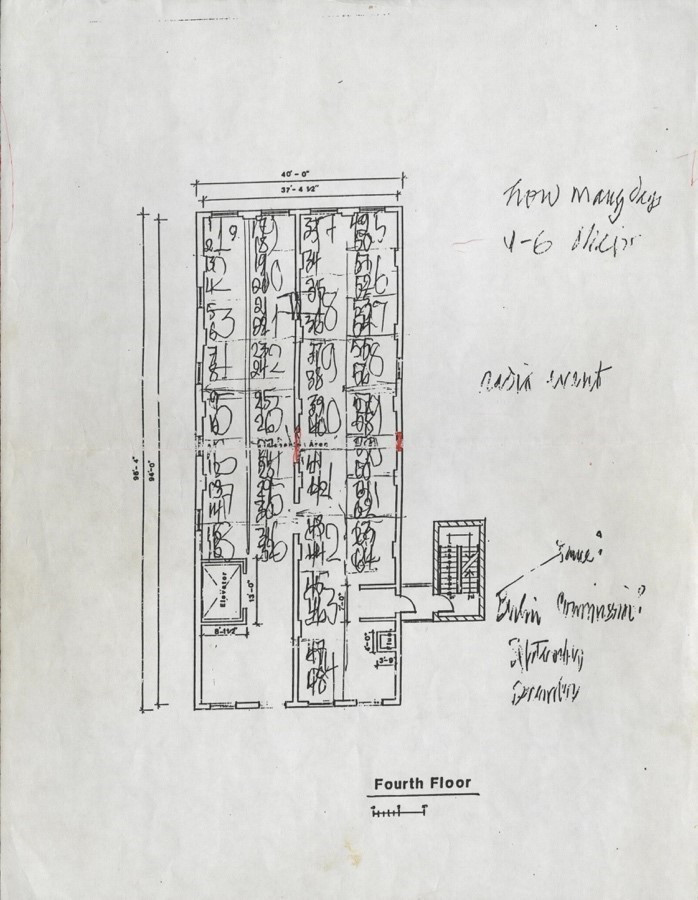
For the installation, Cage chose the fourth floor of the Mattress Factory, which back then was a working space and had a rough and unfinished look. The brick walls were exposed, showing marks and signs of past activities in the room. There were also large windows and a lot of natural light.
Cage made a grid of the gallery floor and walls, and he assigned a number to each grid space as well as to each work and each chair (figure 3). Cage then used those numbers in his computerized chance operations program (IC) to determine a new layout for the wall hung works and the chairs each day. Another element of the composition was a camera that was positioned differently every day according to a score. This camera made a chronicle of the changing gallery as it itself changed position, registering the impact of the natural light as an additional element in flux.
In an interview with Joan Retallack, Cage said that what he enjoyed most in Changing Installation was that for each of the 105 days of the exhibition, every day was different and no two days were the same. He also added that for Rolywholyover, he would want to extend those daily changes and retain marks and traces of daily changes on the wall: “The marks that are already on the walls will be left – like that mark over there (pointing at a wall), or these. I love these things to happen. All that kind of thing will be left” (Cage 1996, p. 135).
2.3 Rolywholyover A Circus, 1991-95
After Cage’s sudden death in August 1992, Rolywholyover A Circus was enacted by Lazar at the Museum of Contemporary Art, Los Angeles from 12 September to 28 November 1993. Later, the exhibition/composition travelled, between 1993 and 1995, to four other galleries and cities worldwide: the Menil Collection in Houston; the Solomon R. Guggenheim Museum in New York; Art Tower Mito Contemporary Art Center; and the Philadelphia Museum of Art.[6]
According to Lazar, Cage’s original idea for MoCA was to create an exhibition of circles, a form representing his long interest in Asian philosophy. In her essay for the Rolywholyover catalogue, Lazar wrote that she suggested a “major, but non-linear, exhibition that reflected his wide-ranging interest” (Lazar 1993, n.p.), and that Cage was amused by this idea. She further noted that he immediately asked for the inventory lists of all major museums nationwide (but readily agreed to settle on ten museums instead), aiming to perform chance operations using his computerized I-Ching system to choose objects for the exhibition from these lists.
From early stages of contemplating the project, Cage wanted to keep the large gallery of MoCA open, where visitors could do “what they want[ed]” (dance, write music, read, etc.) while experiencing other happenings around them. Cage asked to turn the gallery into a place where one can live, and to include plants, rocks, books, chess tables, chairs, and even a jacuzzi (the latter wasn’t approved). He also asked for the use of available daylight where possible and the inclusion of live performances and videos.
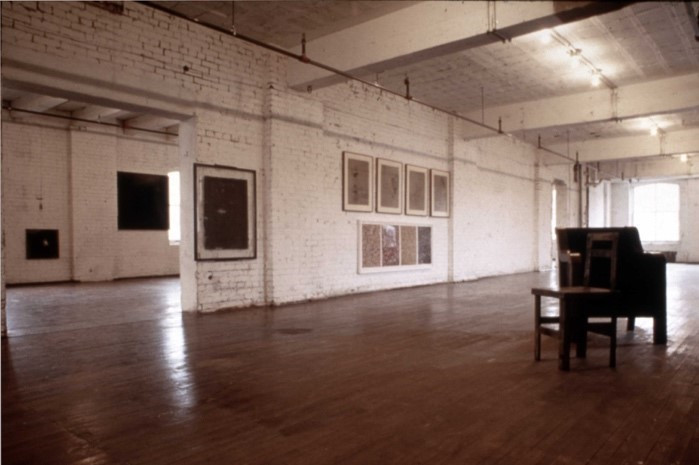
The Rolywholyover composition eventually included four movements: Circus, museumcircle, Cage Gallery and City Circle. For Circus, Cage created a list of artists and works he wished to include. This made it like Changing Installation in some ways. But where Changing Installation had four artists, Circus proposed more than 50 artists. Among these artists were Dove Bradshaw, Joseph Cornell, Merce Cunningham, Marcel Duchamp, Morris Graves, Jasper Johns, Louise Nevelson, Robert Rauschenberg, Robert Ryman, Fanny Schoening, Mark Tobey, and Cy Twombly.
In keeping with his understanding that in sound there is no such thing as an original note, Cage allowed copies and replicas to be incorporated into Circus. Each work (or replica) was numbered, along with the gallery walls (in some locations there were movable walls). These numbers were then inserted into ROVER, a chance-derived computerized score which indicated – daily! – the new placements, order and setting of the gallery.[7]
There were other new aspects in Circus too. The score also indicated the times that changes in placement order or setting should take place, which, unlike Changing Installation, were always during opening hours. Visitors could witness the computer printing out generated changes, which in turn were translated to works being hung on the walls and taken down by gallery installers before visitors’ eyes.
Another big change Cage composed for Circus was to include “storage” as one of the possible locations of “display”. Therefore, every work might by chance stay in “storage” throughout the period of the show (this “storage” space was actually inside the gallery, with the works not on display piled up, signalling the possibility of something beyond one’s view).
The two other movements were Cage Gallery and City Circle. The former was a room with scores, prints, watercolors, and drawings that Cage had done at Crown Point Press and at the Miles C. Horton, Sr., Research Center in Mountain Lake, Virginia; the gallery followed a chance-derived installation plan recommended by Cage. Meanwhile, City Circle consisted of live and videotaped performances in celebration of “the spirit of Cage, by the city’s most innovative artist” as the show’s press release put it. The schedule of performances weren’t published, in keeping with Cage’s own wishes. It was further explained in the museum’s press release that “the schedule remains unannounced until the day of the event, allowing visitors to experience in another fashion the serendipity of chance” (Lazar 1993, n.p.).
The word Rolywholyover, which was coined by Irish novelist and poet James Joyce in Finnegans Wake (1939), was chosen by Cage to characterize his composition for MoCA as a celebration of dynamism and change. Following the word “Rolywholyover” are three silent spaces, then “A Circus”. This titling implied, firstly, that Rolywholyover A Circus was a performative event. Secondly, this titling strategy implied that Rolywholyover was a continuation of Cage’s ongoing research on silence.
As in 4’33’’ and 0’00’’, where audiences became part of their “silent” experiences, Rolywholyover empowered visitors and art installers as performers and participants. While they were dealing with the objects displayed – moving chairs, playing chess, reading books, etc. – they were adding sounds and themselves becoming part of the work. The dynamic nature of the exhibition allowed visitors to return to the galleries often and to experience it differently each time (Cage 1993, p. 17). Through the marks on the walls left from previous hangings, visitors could also experience time passing, as well as the reminder that something happened while they were away – that there were things happenings beyond their experience.
Another performative element in Rolywholyover was its circus-like structure. There was no right way or specific order in which to experience the exhibition’s four movements – it all happened at once, and spectators could enter and exit the movements from multiple points. This format of display followed Cage’s doctrine of a plurality of centres, a concept which was at the heart of his practice.[8] When interviewed by Jeremy Millar in 2010, Lazar said,
In a Cage circus, events take place simultaneously within a single space, and audience members come and go randomly. There isn’t a specific beginning, middle or end – if you can’t hear or see everything in the room, that’s okay, you can at least see and hear something of interest. (Cited in Cage 2010, p. 42)
Moreover, the use of Cage’s circus-like structure ensured that Rolywholyover was, rather than a conceptual object made by one person, a conceptual process that engulfed the spectators and made them, intentionally or unintentionally, part of a group that set the process in motion. As such, the structure of this composition for museum can relate to what Richard Kostelanetz defines in The Theatre of Mixed Means (1968) as “pure happening”, for it “provides neither a focus for one’s attention nor sense of duration; and the performance envelops the audience” (Kostelanetz 1968, p. 5).
Kostelanetz wrote the above statement at a time when Cage’s music was becoming more and more social and anarchic, with compositions that included direct statements such as “we don’t need government” (Untitled Anarchist Poem, 1966) or “the best government is no government at all” (The Song Book, 1970).
Yet, according to Cage, he wasn’t practicing politics because “[p]racticing politics consists in accepting and using the principle of government” (Cage 1981, p. 60).[9] For him, the way to influence and make change was by composing a music of social process and opening up his scores for interpretation. As he wrote in the foreword to A Year from Monday (1967), “When you get right down to it, a composer is simply someone who tells other people what to do. I find this an unattractive way of getting things done” (Cage 1967, p. ix-x).
Accordingly, in Rolywholyover Cage gave visitors the opportunity to discover their own pathways. He hoped that one would experience his composition via a “tourist attitude”, offering to “act as though you’ve never been there before” (Cage 1996, p. 129-30). This offer holds the key to Cage’s museum compositions, which claim to find the way while getting lost. He detached the gallery space from permanent definitions, and by doing that manifested his exhibition as what Jean-Luc Nancy calls a space “on the edge of meaning” (Nancy 2007, p. 7).
The visitors to Rolywholyover were invited to explore, investigate, and ask questions. They were invited to “listen” to the exhibition – and not just to listen with their ears, but rather to listen as Nancy articulates listening: as attentiveness toward or in an approach to the truth (Nancy 2007, p. 4). By extending this invitation to visitors, Cage neutralized the “sanctity” and control of the museum, displaying instead transparency and vulnerability. This act brought the Rolywholyover exhibition to a fragile position, where truth resides, and in doing so, it opened up new possibilities for dialogue – possibilities where visitors hold active roles in what happens within the exhibition.
Further, by composing Rolywholyover as a performative space, Cage infused experience as part of the exhibition, while also offering the visitors the opportunity to take part. Spectators were able to open drawers, move chairs, sit and play chess, read the displayed books, touch objects, and talk openly. Through this openness, Cage offered visitors the opportunity to be part of the creative act itself. He placed the final tune (whether a crescendo or a fadeout) in their heads and hands.
In her essay for the Rolywholyover catalogue, Joan Retallack explored realms relevant to Cage’s museum experience, focusing on Cage’s conception of play, which unfolds “at the moment of any disruption of habit” (Retallack 2003, p. 223). Retallack quoted the British psychoanalyst D.W. Winnicott: “[p]laying is an experience, always a creative experience” (Retallack 2003, p. 233). Such a concept suggests that the museum, in Cage’s composition, can also be read or structured as playground – and not as an entertainment complex or an educational establishment. Museums, Rolywholyover asserts, can be a place where visitors dynamically engage with artworks, with other visitors, and with the exhibition space itself.
Also, the museum can “[invite] a practice or reading that enacts a tolerance for ambiguity and a delight in a complex possibility” (Retallack 2003, p. 221), as Retallack suggests by quoting a line from Cage. This mode of active museum experience – that is, engaged in a selective and critical investigation of the space through play – is what Clarice Lispector articulates in Água Viva (1973), as listening “absentmindedly” in order to “fish” the meaning between the lines (Lispector 2012, p. 15).
Cage’s notion of play is also why Rolywholyover was well received (and likely well perceived), even though it had no labels or didactic panels; even though musical performances happened without any announcements; and even though the museum looked as though it was permanently in the middle of installation processes. This is a piece that maintained and retained the curiosity of its audiences. In her notes from a school field trip she arranged early in her teaching career, Sara Wilson McKay describes her students’ experience of the Rolywholyover iteration that took place at the Menil Collection in Houston:
[The students] saw works being hung and taken down right in front of them... Pieces were listed by numbers, not names and artist identifications, and hung in unusual ways... Additionally, just outside the large gallery, there were drawers and drawers of items connected to Cage such as letters from Ad Reinhardt and sketches and ideas from Merce Cunningham. (Wilson McKay 2009, p. 62)
According to Wilson McKay, who is now Associate Professor of Art Education at Virginia Commonwealth University, the opening of each drawer revealed new and unexpected bits of information that unfolded the exhibition structure, “making the students want to see more” (Wilson McKay 2009, p. 62).
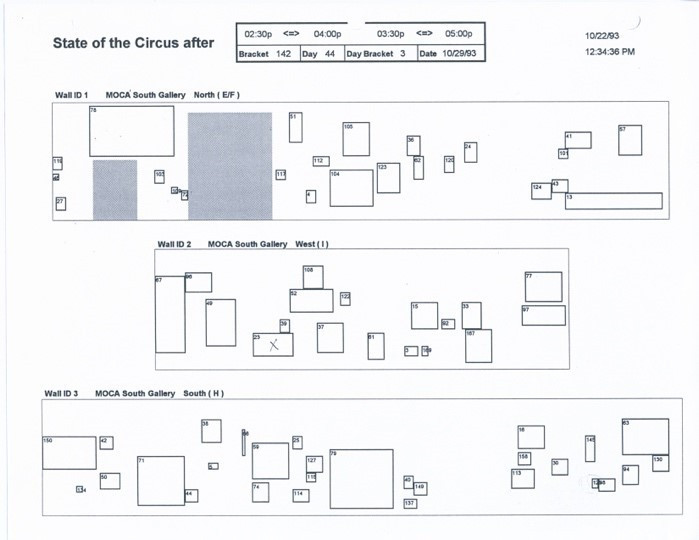
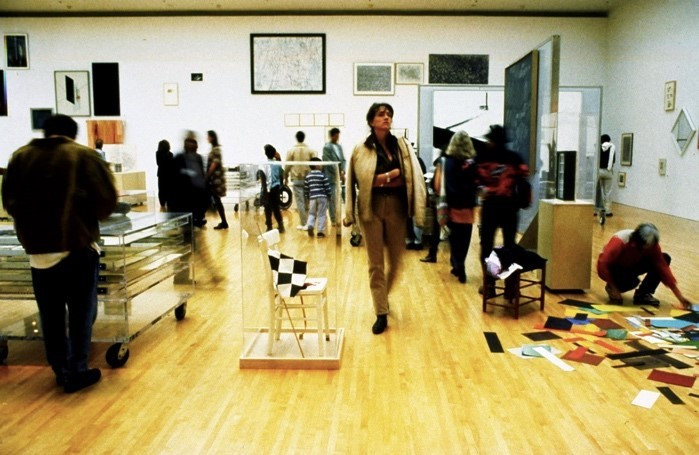
3. Museumcircle: Cage’s space adaptation of Duchamp’s Erratum Musicale (1913)
According to Lazar, “Cage acknowledged Erratum Musicale as a source for his idea for museumcircle and for how it would operate”.[10] Erratum Musicale is the first musical work of Marcel Duchamp – a chance-based score for three voices. In museumcircle, while adapting Duchamp music to a sculptural space, Cage demonstrated the potential of translating a musical score into a curatorial method for displaying objects in space.
3.1 Erratum Musicale (1913)
Erratum Musicale is the first of only two musical compositions that Marcel Duchamp composed, in addition to one conceptual sound piece.[11] Along with other projects in a series from 1913, Erratum Musicale threw into question the concept of the work of art. In an interview Arturo Schwarz conducted with Duchamp for his book The Complete Works of Marcel Duchamp (1969), the artist revealed that around the end of 1912 he began having doubts concerning the concept of the work of art, which led him to create a variety of projects dealing with what he called the “beauty of indifference” (Schwarz 1969, p. 35). These doubts brought about the first readymade the following year – a bicycle wheel on a kitchen stool (Bicycle Wheel, 1913), and along with it the declaration that it was the artist’s power of selection and choice that turned any object into a work of art.
Another project from the same year was 3 Standard Stoppages, in which Duchamp used chance to explore the idea of a metre. In this work, Duchamp threw each of three metre-length threads onto a separate rectangular canvas. He later painted each canvas and announced them as a new unit of measure: Duchamp’s metre. The same three chance-derived shapes were also used by the artist to create three “standard stoppages” carved from three wooden metre sticks. But Duchamp’s work with chance didn’t start with 3 Standard Stoppages. According to Schwarz, it was with Erratum Musicale that Duchamp first exploited chance in his practice, applying it to the temporal dimension rather than to the spatial.
Duchamp wrote Erratum Musicale for three voices – his two sisters and himself – and he titled each part after their names: Yvonne, Magdeleine, Marcel. The three voices are written out separately, and there is no indication whether they should be performed individually or together as a trio. In composing this piece, Duchamp made three sets of 25 cards, one for each voice, with a single note per card. Each set of cards were mixed in a hat, then drawn out one card at a time, with the series of notes written down in the order in which they were drawn. Like his use of readymades, the words that accompanied the musical notes were from a French dictionary’s definition of imprint: “imprimer” – Faire une empreinte; marquer des traits; une figure sur une surface; imprimer un scau sur cire (“imprint”: to make an imprint; mark with lines; a figure on a surface; impress a seal in wax).
Erratum Musicale embodied the same ideas as 3 Standard Stoppages or Bicycle Wheel, but this time examining a composer’s role. As such, the theory behind Erratum Musicale, according to Schwarz, owed to Lewis Carroll’s guide for becoming a poet in Poeta Fit, Non Nascitur (1869): “For first you write a sentence/And then you chop it small;/Then mix the bits, and sort them out/Just as they chance to fall:/The order of the phrases makes/No difference at all” (Carroll 1929, p. 125). The title of Carroll’s poem is a play on the Latin proverb poeta nascitur, non fit, which means “a poet is born, not made”. By inverting it, Carroll counters that a poet is made, not born. Duchamp takes it from there, and as he chops the notes and words for Erratum Musicale, he alters the concept and process of being a composer.
Like most of his Dada contemporaries, Duchamp left no medium untouched. His musical works represent a radical departure from anything done up until that time in music, most notably because they showed that you did not need to be a composer to compose music. His three musical works are considered difficult material to work with, for there are very few comments or explanations by the artist to assist with resolving the pieces. They can be considered precedents to the Fluxus pieces of the early 1960s, where works combine unknown factors and elements, explained and unexplained.
The Czech-American composer and conductor Petr Kotik explained in his preparatory notes toward the performance of Duchamp’s composition that the lack of instructions forces a process of interpretation, a process which can later result in “an event/happening, rather than a performance” (Kotik 1991, n.p.). Kotik suggests that the performance of Duchamp’s randomly ordered notes and textual repetitions allows the process of composition to be both heard and seen. It therefore uses sound to construct a visual space in what seems analogous to an abstract experience of a sculptural space. This spatial realization of sound provoked a scandal, according to the French Dada artist Georges Ribemont-Dessaigne who acted as the page-turner for the first public performance of Erratum Musicale.
The performance took place at the “Dada Demonstration” on 27 March 1920 in the Théâtre de l’Oeuvre in Paris. Ribemont-Dessaigne was “overwhelmed by an unprecedented din that was made up of this terribly dissonant music, and the restlessness, shouts, and whistling of the audience, all of which united with a crash of broken glass to give a truly most curious effect” (Ribemont-Dessaigne, 1958, pp. 70-71).
3.2 museumcircle (1991)
Following Duchamp’s usage of found words from a dictionary, Cage composed museumcircle’s score as a list of instructions as well as a description on how to use chance for creating a pool of objects for the exhibition. The first instruction, for example, is to send an open call to all public lending institutions (fine art, natural science, natural history, aerospace, anthropology, etc.) within a radius of thirty miles from each hosting city, inviting them to submit a list of ten objects from their collection. There are no guidelines provided regarding the preparation of this list. One object from each list was then selected according to a list of numbers created by Cage’s computerized I-Ching program, named IC.[12]
The museumcircle IC list consists of 640 randomly repeating numbers between one and ten and chosen by chance-operations, with the object from the museum’s lists then selected according to the order of their arrival. For example, if the first item in the IC list is the number two, then object number two is selected from the list of ten objects that is first to arrive. If the second item in the IC list is the number five, then object number five is selected from the list of objects that arrives second, and so on. These objects, together with scores, rocks, plants, shelves with reference books similar to those found in Cage’s private library, chess tables, and pieces of ephemera constitute the elements of museumcircle.
Again, following Duchamp’s chance methodology for Erratum Musicale, each object was numbered, as was each potential placement in the spatial grid (which Cage designed together with the museum registrar). These numbers were later pulled by the museum staff from two “hats” (in fact, cardboard boxes), one for the objects and the second for the spatial grid of the gallery. These artifacts, together with the above mentioned items and pieces of ephemera, constituted the elements of museumcircle, allowing visitors to enjoy “life-like” experiences in the gallery, such as playing chess and reading books.
I would maintain that unlike Duchamp’s Erratum Musicale, Cage’s museumcircle did not aim to be provocative or critical regarding the institution of art. Accordingly, the spatial grid was conceived with utmost respect to the objects on display. For instance, objects were not to be hung too low, where they might be mistakenly damaged, or hung upside down or backwards. While the participating institutions were listed in the accompanying box composition publication (which needed to be printed prior to the tour), the selected objects were not. Moreover, no labels were placed beside the objects, though they were numbered and an enumerated list of all the objects on display was available in each gallery.
In museumcircle, Cage achieved a critical break between the artist’s ego and the work itself – a break previously described by Duchamp in “The Creative Act” (1957). In this text, Duchamp describes the role of the spectator in the encounter with a work of art as the revival of the creative act, what he called the “art coefficient”. In Erratum Musicale, the performer created his own interpretation of the musical score, which was later interpreted by the spectator, as an abstract musical sculpture. In contrast, in museumcircle we witness Cage redefining the creative act, pushing at its limits via his interpretation of Duchamp’s musical work. Cage created a spatial composition to be completed by the spectators, whose activities – such as moving chairs, opening drawers, playing chess, talking, and touching – produced sounds and thereby became part of a musical experience.
Julia Robinson suggests that Cage’s redefinition of the creative act was part of his strategy of “self-authorizing”, a process through which he aimed to operate beyond the limits of musical discourse and that initiated his model of “Experimental Composition”. This, according to Robinson, was part of Cage’s effort to turn musical composition as intervention into a new discipline. “But,” she states, “it was the composer-performer-audience basis of his own discipline […] that first allowed him to contemplate the public register of the creative act” (Robinson 2010, p. 56). In museumcircle, Cage transformed the museum experience into musical experience by composing an exhibition as an event, and by doing so he added the performative act to the creative act.
When Cage was asked by Moira and William Roth about the differences between Duchamp’s idea of chance and his own, he referred to Erratum Musicale, saying that he wouldn’t be satisfied with pulling notes out of a hat, but that he was delighted with it in Duchamp’s work. Cage indicated that he preferred his version of chance to be more intricate, but that, according to him, the main difference in their perspectives to chance “probably came from the fact that he was involved with ideas through seeing, and I was involved through hearing” (Roth 1973, p. 72). Cage goes on to define Duchamp’s use of chance as a form of translation based in language, in contrast to his own goal, which is “to set a process going that is not related to anything” (Roth 1973, p. 76).
Consequently, the open call for the city’s public lending institutions to submit a list of ten objects is the main difference between museumcircle’s and Erratum Musicale’s chance methodology. While Cage used chance to create his pool of objects, Duchamp used chance as a method of selection. While the former opened his score to include any object, the latter closed off outside possibilities by determining the notes and words that were used. Thus, as with his musical pieces, Cage used chance to conduct an unpredictable process that would surprise first of all himself, while Duchamp, as a conceptual artist, used chance as a translation tool in turning his ideas to conceptual objects.
Sophie Stévance rightfully crowns Duchamp as the inventor of what she calls “conceptual music”. In her essay “John Cage Tunes Into the Redefinition of the Musical Field by Marcel Duchamp and the Emergence of a Conceptual Music”, Stévance states that through his compositions, Duchamp offered an experience in which the truth of music no longer depended on its acoustic dimension, but rather on its conceptual dimension; music becomes an object that leads to listening as thought. Duchamp’s music might be “useless performance in any case” (Duchamp 1991, p. 50), as he himself suggested, but from an epistemological stance, his compositions, similar to other objects he worked with (such as the bicycle wheel), should be valued for the ideas they hold. Duchamp the composer showed that music could function on another level besides sound, one in which it does not necessarily need to be played.
This observation is crucial to the understanding of museumcircle as Cage’s spatial adaptation of Erratum Musicale’s conceptual sound, and accordingly, understanding how it supports the argument that Cage’s composition confronts the role of the curator. However, I maintain that by using his own chance methodology, Cage managed to avoid the snare of imitation. By transforming Duchamp’s translative chance methodologies to his own chance operations, Cage managed to exceed being provocative and composed a process-based exhibition that holds an offer “to get yourself in such a state of confusion that you think that a sound is not something to hear but rather something to look at” (Cage 1961, p. 183).
4. Emptiness/nothingness/silence – Cage’s exhibitions as the evolution of his silence
Cage, who died in 1992, did not live to write his own thoughts and reflections about his compositions for museums. However, from a set of interviews he gave to Joan Retallack concurrent to working on these projects, we can learn about his ideas and intentions. Specifically, his comment on the mode of the art exhibition:
You know that I have a kind of basic idea that music is music and painting is painting, but I’m having recently new ideas, or I’m getting ideas from one field that work in a different field… For instance, the percussion piece that dips into silence. An exhibition can dip into leaving a wall empty. And it’s out of that emptiness, and not being put off by “nothing” happening – and when you see it, it really impresses you – that hearing it, hearing the emptiness, becomes a possibility all over again. (Cage 1996, p. 91)
Following the above declaration, the last part of this essay articulates the aesthetics of Cage’s compositions for museum as the spatial extension of his silence, exploring the meaning of emptiness and nothingness as he himself suggested.
4.1 4’33’’ (1952)
The story is familiar. In 1951 Cage visited the anechoic chamber at Harvard University with deep concern for the opposition between sound and silence. While expecting to experience no sound, he was completely surprised to hear two sounds: one high and one low. According to Cage, the technician who worked there informed him that those sounds were his own, the high was his nervous system in operation and the low his blood circulation. This experience made it clear for him: there was no such thing as silence, there was always something to hear, something to see. This experience, followed by a viewing of White Painting (1951) by Robert Rauschenberg, encouraged Cage to create something similar in music.[13]
4’33’’, also known as his silent piece, is probably Cage’s most famous work. Those familiar with the composer’s name are most likely to be familiar with it (as well as have a strong opinion about it). The piece is in three parts of fixed lengths: 30’’, 2’23’’, and 1’40’’ (for a total duration of 4’33’’). According to Cage, this duration was chosen by chance after adding many shorter durations of silence (Cage 1990, pp. 20-21). It was premiered by pianist David Tudor at a Woodstock Artists Association concert in August 1952 at the Maverick Concert Hall in Woodstock. The performance involved Tudor sitting in front of the piano, holding a stopwatch in his hand and not playing a tune for exactly 4 minutes and 33 seconds.
The piece wasn’t well received at its first performance, and the long-lasting debate on the essence of Cage’s silent piece began, gaining proponents as well as opponents. Those who see it for the ground-breaking piece that it is – one that completely changed the field of contemporary music – understand that 4’33’’ reveals there is no such thing as silence. With this fundamental shift in perception, sound and silence are no longer opposites, but rather parts of a large field of aural experience. Silence, in fact, is sound that one does not expect to hear and, therefore, is not the absence of sound, but rather the presence of unintended sounds. Those who are detractors simply see (or hear) no beauty in a performer not playing his instrument.
To fully understand Cage’s thoughts on 4’33’’, we may look into the philosophy that preceded this work, starting with the spiritual path that led him to conceive the piece. The mid-1940s was a critical time for Cage. He was in a difficult place in his personal life as well as his professional life. He had studied with Arnold Schoenberg and realized he wasn’t interested in harmony. He had invented the prepared piano and begun composing music for dancers. He had also met the young dancer Merce Cunningham, and separated from his wife, the artist Xenia Cage. These events made Cage question his own identity,[14] and as he explained in an interview with Holly Martin, he was looking for something more – a reason, a meaning to devoting his life to music (Cage 1976, n.p.).
He would find some answers in an encounter with Gita Sarabhai. Sarabhai, an Indian composer who was worried about the influence of Western culture on traditional Indian music, came to the United States to study Western music. She asked Cage if he could teach her and he agreed to do so for free if she would teach him Indian philosophy and music. When Sarabhai returned to India she gave him The Gospel of Sri Ramakrishna. Sarabhai taught Cage that “the traditional reason for making music in India was to quiet the mind and thus make it susceptible to divine influences” (Cage 1976, n.p.). Other answers he found in the writings of Ananda K. Coomaraswamy, whose lectures he attended at the Brooklyn Academy of Music in 1945 and 1946. Coomaraswamy’s The Transformation of Nature in Art influenced Cage, in particular teaching him “that the responsibility of the artist is to imitate nature in her manner of operation” (Cage 1976, n.p.).
While Sarabhai and Coomaraswamy planted the seeds of Eastern wisdom in Cage, affecting his life and practice, it was his exposure to Japanese Zen Buddhism in the lectures of Dr. D. T. Suzuki at Columbia University (between 1948 and 1951) that really altered his world view. Cage makes one of his few extended references to Suzuki’s teaching in his collection of essays Silence, elaborating on Suzuki’s take on the difference between Oriental and European thinking: “In European thinking things are seen as causing one another and having effects, whereas in Oriental thinking this seeking of cause and effect is not emphasized but instead one makes an identification with what is here and now” (Cage 1961, p. 46).
Cage goes on to share how Suzuki specified two qualities: unimpededness and interpenetration: “unimpededness is seeing that in all of space each thing and each human being is at the center... Interpenetration means that each one… is moving out in all directions penetrating and being penetrated by every other one no matter what the time or what the space” (Cage 1961, pp. 46-47).
The idea that each and every thing is at the centre came to be a central theme in the Suzuki-influenced Buddhism that Cage adopted. As he said:
[T]his doctrine of nonobstruction means that I don’t wish to impose my feelings on other people. Therefore, the use of chance operations, indeterminancy, etcetera, the nonerection of patterns of either ideas or feelings on my part, in order to leave those other centers free to be the centers. (Kostelanetz 2003, p. 225)
Honouring all things (including all sounds), refusing intention, and embracing the unpredictable would be the themes that carried Cage’s practice forward.
This brings us back to 4’33’’ and the meaning of Cage’s silence. When Cage introduced his new ideas to the Woodstock audience in 1952, most of them (if not all) did not listen. Maverick Concert Hall is an open auditorium – meaning it’s open acoustically to the sounds that surround it. Therefore, the audience might have heard the sounds that entered freely inside, but it wasn’t music to their ears. They saw it as a political act, a provocative performance of some sort, not as pure music.
It is important here to note that, only a few years earlier, Cage himself might have shared the same feelings as his Woodstock audience. In 1948 he wrote “A Composer’s Confession”, which outlines his career in detail up to that point, ending with two pages of some of his “recent ideas”. Cage refused to publish his “Confession” until the end of his life, primarily because of the final section, which, as previously noted, upset the traditional Cagean lore of his famous silent piece. He wrote:
I have, for instance, several new desires (two may seem absurd but I am serious about them): first, to compose a piece of uninterrupted silence and sell it to Muzak Co. It will be 3 or 4 ½ minutes long – those being the standard lengths of “canned” music – and its title will be ‘Silent Prayer.’ It will open with a single idea which I will attempt to make as seductive as the color and shape and fragrance of a flower. The ending will approach imperceptibility. And, second, to compose and have performed a composition using as instruments nothing but twelve radios. It will be my Imaginary Landscape No. 4. (Cage 1948/2014, n.p.)
Cage refers here to Muzak Holdings, often simply referred to as Muzak, a brand that delivers background music to retail stores. His idea to sell silence to Muzak in order to bring it back to the background of our lives can indeed be read as a political act – one that operates against the music industry which turned the space between us, the silence, into a commodity.
This passage from “Confession” also surely suggests that his initial ideas were there before he encountered Rauschenberg’s White Painting in 1951, and that 4’33’’ wasn't the result of some sort of enlightenment or a sudden persuasion (as in the school of Zen which he preferred),[15] but rather part of a longer endeavour. Above all, what “Confession” reveals is that, in 1948, his ideas about silence – along with his concerns about the way we can ruin it – were different from our conventional understanding of Cage. Silence was then taken, literally, as the absence of sound.
This is not to say that Cage’s encounter with Rauschenberg’s painting in 1951 didn’t have any influence on the process of realizing 4’33’’. It surely did. But it wasn’t the only factor that led to a sudden enlightenment. Therefore, I would maintain that in 1952, at the time he composed 4’33’’, Cage might have considered that all sounds are equal, and that creation is endless; even that sound and silence are not opposites.
But still, in contrast to one of the above dictums, he chose to leave an impression. And that was because 4’33’’ is a specific orchestrated situation, that of a pianist not playing the piano, onstage, for a determined period of time. These were a set of decisions that made 4’33’’ obstructive and penetrative (and against Suzuki’s doctrine). The uproar of this first performance in Woodstock, and the long-lasting debate around this piece, are the result of those decisions, all of which he would change in composing 0’00’’ roughly ten years later.
4.2 0’00’’ (1962)
James Pritchett states that the distinction between object and process describes Cage’s music from the 1960s onwards when Cage “had moved from arranging things to facilitating processes” (Pritchett 1993, p. 146). Pritchett owes this change to the recognition Cage received after his ground-breaking ideas on silence and chance in the 1950s, with works such as Music of Changes (1951), The Ten Thousand Things (1953-56), and, of course, 4’33’’ (1952). This recognition affected the scope of Cage’s work.
Accordingly, between 1952 and 1959 Cage accomplished about forty compositions, but between 1962 and 1969 he completed only fifteen due to obligations that had to do more with his career than his music. Because of this situation, Cage began including his life in his compositions.[16] With life and music becoming one and the same, Cage’s music shifted from being a compositional object to being a compositional process – now focusing on the potentiality of sound. Among those works is 0’00’’, which is the third and final piece in a series corresponding to the three lines of a Haiku poem.[17]
0’00’’ is considered as Cage’s 4’33’’ no. 2. Yet the compression between 4’33’’ and 0’00’’ shows the evolution of Cage’s understanding of silence over a decade or so. While 0’00’’ is a “solo to be performed in any way by anyone”,[18] 4’33’’ is a “tacet, for any instrument or combination of instruments”.[19] It’s clear that you don’t need to be a musician to perform 0’00’’, whereas 4’33’’ invokes the presence of unplayed instruments. But that does not mean that 0’00’’ has no sound component, or that Cage’s focus wasn’t on the sound, or even that this is not a musical work. The evidence for the importance of sound is in the score, which contains only one sentence: “In a situation provided with maximum amplification (no feedback), perform a disciplined action.”
In naming amplified sound, Cage clearly shows great concern for sound in 0’00’’. This time, however, the focus was not on the unintentional sounds of the “silent” performer(s) and their audience(s). Rather, 0’00’’ was all about the unintentional sounds of an undetermined action. Accordingly, a day after writing the score, Cage added instructions to allow interruptions of the action, to avoid repetition of the same action in another performance, and to exclude any action of a performative musical composition. These amendments show the evolution of his understanding of silence. In 4’33”, silence is comprised of the unintentional sounds of a composed situation. In 0’00”, the silence is comprised of unintentional sounds of the uncomposed – that is, it is a piece that follows from the Zen Buddhist doctrine of non-obstruction, freeing the performer to follow their own centre.
The use of technology in amplifying the sound of any action in 0’00’’ is another means of creating new, inbetween territories. As Douglas Kahn notes, when Cage began using amplification to render audible range of small and inaudible sounds, “he amplified amplification, extending audibility (thus musicality) to increasingly smaller sounds and to all sounds all the time” (Kahn 1997, p. 585). As Cage noted, 0’00’’ is “the continuation of one’s daily work ... without any notion of concert or theatre or the public, but simply continuing one’s daily work, now coming out through loudspeakers” (cited in Kostelanetz, 2003, p. 69-70). He also claimed that “the piece tries to say … that everything we do is music, or can become music through the use of microphones... By means of electronics, it has been made apparent that everything is musical” (Kostelanetz 2003, p. 70).
The idea that the amplification of the everyday life is a new territory of the in-between – which in turn is the performance itself – relates to the Japanese term “ma” (which Cage and other artists, such as La Monte Young, and Yves Klein, were aware of). “Ma” is defined by Iwanami’s Dictionary of Ancient Terms as “the natural distance between two things existing in continuity” (cited in Isozaki 1979, p. 12). Therefore, “ma” means an interval between two (or more) spatial or temporal things and events. But it also means “among”: the relational situation of a person standing in, with, among, or between something or someone else. It carries both objective and subjective meaning; it is not only “something”, but also signifies a particular mode of experience – the experience of the in-between.
Taking this idea further, we can see that “ma” represents a moment in which time and space collapse, in which silence/emptiness is not a break or a pause or a void, but rather the potential path for whatever might pass through it. Richard B. Pilgrim suggests that art is the ultimate form where “ma” can be experienced. Using the Japanese theatre as an example, he shows how ma is the empty stage at the moment before it is filled with the next act. In another example, he shows how the facial expression of the actor may hold this feeling the moment before something new happens and changes what they felt before. Pilgrim notes that our understanding of “ma” should not be limited to a “place” or “place-making” or to form/non-form, but should extend to “form/non-form as imaginatively created or perceived in immediate experience” (Pilgrim 1986, p. 266).
This leads me to the main difference in the silence Cage presented in 0’00’’ versus the one in 4’33’’: the element of time. While 4’33’’ had a determined time frame of 4 minutes and 33 seconds, 0’00’’ accepted any given time, including no time at all. In other words, 4’33’’ needed to be performed in order to produce this experience of silence, whereas 0’00’’ did not. Silence is no longer “just” everywhere, in everyday life; it is everything, including us all.
To explain this assertion, I will use The Heart Sutra, a famous short Buddhist scripture that was one of Cage’s favourites. As is well known, nothingness/emptiness stands at the centre of all forms of Buddhist thought, including Zen Buddhism. The dialectic of emptiness, through its three stages, is explained well in The Heart Sutra (estimated by Edward Conze to date from 350 CE). An excerpt states that “form is emptiness and the very emptiness is form; emptiness does not differ from form, form does not differ from emptiness; whatever is form, that is emptiness, whatever is emptiness, that is form.” (Conze 1958, p. 81).
Conze, whose commentary and translation to this scripture were also recommended by Cage, notes that Emptiness is the same as Nirvana and the same as Buddha, and “on another level of spiritual awareness Nirvana may reveal itself as the same as this world” (Conze 1958, p. 81). Emptiness is therefore the transcendental: “[I]t is nowhere, and nowhere it is not. This is the mystical identity of opposites. Nirvana is the same as the world. It is not only ‘in’ and ‘with you,’ but you are nothing but it” (Conze 1958, p. 83).
4.3 Emptiness – Cage’s compositions for museum
Based on chance, Cage’s compositions for museum, like his other musical compositions, fully embraced the possibility of everything, including nothing at all. The Circus’s “storage” is one example, embracing the possibility that if all the works are “stored”, the walls could be left empty. Another example is in Cage’s instructions for museumcircle: that no forms of persuasion should be enacted on participating institutions. This prohibition against persuasion could, again, if no one responded, leave the gallery walls empty. But the most significant impact of Cage’s chance operations is the space free of any didactic meaning – there was no narrative on display, and there was no visible order. Henri Bergson describes this as the “existence of the nought” (Bergson 1975, p. 287-315). What we see is the indication of what we don’t see. Disorder is only the absence of order, and nothing is the indicator for everything.
Further, Cage’s compositions for museum engulfed the spectators in an environment of “pure happening”, allowing space for Suzuki’s doctrine of non-obstruction. Or, in Cage’s words:
From a non-dualistic point of view, each thing and each being is seen at the center, and these centers are in a state of interpretation and nonobstruction. From a dualistic point of view, on the other hand, each thing and each being is not seen: relationships are seen and interferences are seen. To avoid undesired interferences and to make one’s intentions clear, a dualistic point of view requires a careful integration of the opposites. (Cage 1961, p. 38)
A “dualistic point of view” could lead to a territory which I outline above as a space of ma – the emptiness/nothingness of the interval, the experience of the in-between. This is how Cage’s compositions for museum act: as the spatial adaptation of silence, as the Emptiness/Nothingness that has the potential to be everything, including nothing at all.
To better understand Cage’s compositions for museum as the evolution of his silence, let’s compare it to attempts by visual artists to display emptiness – that is, the display of the empty gallery. Yves Klein’s The Specialization of Sensibility in the Raw Material State into Stabilized Pictorial Sensibility: The Void (1958), for example, aimed to display in the empty gallery only the aura of the artist. Robert Barry’s Closed Gallery Piece (1969-79) was no more than a sign on the gallery door declaring the empty gallery’s space to be closed. Robert Irwin created a variation of this in Experimental Situation (1970): as it was stated in the exhibition publication, the gallery would be empty for a period of one month, during which Irwin would visit the space daily to conceive different possibilities of artwork for the space.
Finally, Chris Burden’s performance White Light/White Heat (1975) displayed the vivid presence of the artist in the gallery (it was said he was lying on a high shelf placed close to the ceiling). There are more examples, but it’s enough to show that the empty gallery is not empty as long as it has only one narrative on display. In other words, it’s not enough to empty a gallery space of objects in order to capture a moment of Emptiness. In Cage’s compositions for museum, the space isn’t empty – it is filled with objects, but it is empty of intended, prescribed meaning. And as such, it is a space of Emptiness.
[1] The Exposition Internationale du Surréalisme was an exhibition by Surrealist artists that took place from 17 January to 24 February 1938 in the Galérie Beaux-Arts, Paris.
[2] This label omission could be read as an agitative act. But according to Lazar, this act was decided on by Cage, together with key museum staff, after realizing the extreme height at which some pieces were to be hung and the proximity of some hangings. According to Lazar, it was Cage’s ongoing interest in “collage” – both in sound art and visual art – that led him to situate “high art” alongside ephemera and non-art objects. She contends that it was this collage interest, along with Cage’s rejection of authorship, that provided the main impetus behind his three compositions for museum.
[3] Ulrich Bischoff, Thomas Dreher, Sigrid Gareis, Robyn Schulkowsky, and Bettina Wagner-Bergel.
[4] More on this in the following section of this essay.
[5] Curated by Lynn Cooke and Mark Francis.
[6] All the information regarding Rolywholyover A Circus, if not noted differently, was provided to me by Julie Lazar, whom I would like to thank dearly for her tremendous help. I would also like to acknowledge the help of Laura Kuhn, director of the John Cage Trust, who gave me free access to the twelve treasure boxes with archival materials of Rolywholyover A Circus.
[7] In her catalogue essay, Lazar acknowledged composer Andrew Culver for programming ROVER: “In this way Culver played a critical role in the realization of Rolywholyover A Circus following Cage’s death” (Lazar 1993).
[8] A variety of circus-like events and compositions preceded Rolywholyover; among them were the happening at Black Mountain College (1952), Musicircus (1967), HPSCHD (1969), and Rorarorio, An Irish Circus on Finnegans Wake (1979), to name a few examples.
[9] “On the contrary, anarchy is concerned only with the absence of government. And I believe that we would be able to live much better than at present if we were in a world which contained no nations – even united nations!” (Cage 1981, p. 60).
[10] Julie Lazar, e-mail message to author, 8 July 2014.
[11] The two other sound works are: Sculpture Musicale and La Mariée mise à nu par ses célibataires même, Erratum Musical. All three sound works are included in The Green Box (1934), which Duchamp published and considered part of his notes for The Bride Stripped Bare by Her Bachelors, Even (1915-23), also known as The Large Glass. The original score of Erratum Musicale was lost and its size was not recorded. In The Green Box there is a facsimile size 31 x 24 cm (cat. 293); this size, according to Duchamp, should be very close to the actual size.
[12] “IC”, as well as the other I-Ching computerized programs Cage used, was programmed by the composer Andrew Culver.
[13] It is interesting to note here the influence Rauschenberg also had on Morton Feldman, one of Cage’s dearest friends. In the early 1950s, Feldman saw one of Rauschenberg’s black paintings, which had black-painted newspapers stuck to it. He said that he immediately had to buy it, and that after living with it for a while, felt he must write music that would deal with being “neither life nor art, but something in between” (Feldman 1985, p. 135-36).
[14] In 1945, after meeting Merce Cunningham in the years prior, Cage separated from his wife Xenia Cage (born Kashevaroff). Being a homosexual in the 1940s was still complicated, and according to some scholars, was one of his main reasons for pursuing spiritual thought. For more information see: K. Larson (2012), Where the Heart Beats: John Cage, Zen Buddhism, and the Inner Life of Artists. New York: Penguin Press.
[15] Cage’s explanation of the sudden school of Zen: “In the sudden school – which I prefer – there are three principal truths. They’re called the whispered truths... [T]he first is that creation is endless, hmm?... [T]he next is that your action should be as though you were writing on water... not to make an impression. And the final thing is to realize that the opposites are not opposite” (Cage 1996, p. 163).
[16] As Pritchett nicely puts it: “If notoriety was going to mean spending all this time answering correspondence, then Cage would adjust his art so that answering correspondence became a musical performance” (Pritchett 1993, p. 144).
[17] Atlas Eclipticalis (1961) is the first in the series, representing “nirvana”, and Variations IV (1963) is the second, representing “samsara”, the turmoil of everyday life. 0’00’’ represents “individual action”.
[18] John Cage Trust, https://johncage.org/pp/John-Cage-Work-Detail.cfm?work_ID=17.
[19] John Cage Trust, https://johncage.org/pp/John-Cage-Work-Detail.cfm?work_ID=18.
